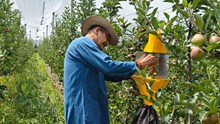
The Purnathadi buffalo, native to Maharashtra’s Vidarbha region, is recognized as India’s 20th registered buffalo breed. Officially designated with the accession number INDIA_BUFFALO_1100_PURNATHADI_01020, this medium-sized breed is highly valued by small and marginal farmers for its adaptability to local climatic conditions, efficient breeding, and notably high milk fat content. Despite its advantages, the breed faces challenges like limited artificial insemination resources, lack of structured breeding programs, and competition from higher-yielding breeds such as Murrah.
Purnathadi Buffalo: Distinctive Physical Traits
Purnathadi buffaloes are medium in size, making them manageable for small-scale farmers with limited grazing land and feed availability. Their coat varies from whitish to light brown, which offers natural heat resistance suited to Vidarbha’s climate. One of their most distinctive features is their long, hook-shaped horns that curve at the ends, a trait that sets them apart from other indigenous breeds. Additionally, white extremities on their legs and a white tail switch provide further identification markers.
Milk Production and Quality
While the Purnathadi buffalo’s milk yield ranges from 353 to 1,533 kg per lactation—lower than some commercial breeds like Murrah—it excels in producing milk with very high fat content, typically between 6.5% and 11.5%. This rich milk is prized for traditional dairy products like ghee, paneer, and cheese, which require high-fat milk for quality and texture. The creamy milk also enjoys strong demand in local markets where consumers prefer fuller-bodied dairy products. This high-fat content enables farmers to command premium prices in markets where fat-based pricing models exist.
Farmers’ Perspectives and Breed Preferences
Surveys across 35 villages in the breed’s native tract reveal that small and marginal farmers prefer Purnathadi buffaloes due to their lower initial cost, efficient reproduction, minimal feeding requirements, and profitability stemming from the high-fat milk. However, larger commercial farmers are increasingly opting for Murrah buffaloes because of their higher milk volume, even though Murrah milk typically has lower fat content.
Challenges Facing the Breed
Despite its benefits, the Purnathadi buffalo’s future is uncertain. A major hurdle is the scarcity of government-supplied frozen semen for artificial insemination, combined with farmer reluctance to maintain breeding bulls, which weakens structured breeding efforts. Genetic purity is also at risk due to crossbreeding with Murrah and the use of non-descript bulls, leading to dilution of the breed’s unique traits.
Economic challenges compound these issues. Summer forage scarcity and rising feed costs make maintaining Purnathadi buffaloes less profitable. Additionally, rural milk markets often price milk based on volume rather than fat content, causing farmers to miss out on fair compensation for the breed’s richer milk.
Steps Towards Conservation and Promotion
To preserve and promote the Purnathadi buffalo, coordinated government and community efforts are essential. Including the breed in subsidy schemes and establishing breed societies would encourage farmers to maintain pure herds. Dairy cooperatives and fat-based milk pricing could improve farmers’ income by recognizing the superior quality of Purnathadi milk.
Moreover, ensuring the supply of proven Purnathadi bull semen through government and NGO channels is critical for genetic improvement. Structured breeding programs can safeguard the breed’s distinct characteristics while supporting sustainable population growth.
The Purnathadi buffalo is a vital indigenous genetic resource, especially valuable for small-scale farmers due to its high-fat milk, low maintenance costs, and adaptability to local conditions. Though it faces genetic and economic pressures, targeted interventions and supportive policies can revive Purnathadi buffalo farming. With proper conservation, improved market access, and breeding programs, this breed can continue to contribute meaningfully to Maharashtra’s dairy sector and India’s rich livestock heritage for years to come.
















